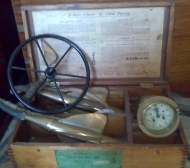
The Nautical Log
This is an instrument for measuring the speed of a ship through water. It derives its name from “log”, a small wood panel tied to a line with a number of knots at uniform spacing to measure speed.
The ship log appeared at the beginning of the 17th century. This instrument consisted of a wooden board weighted with lead and tied to a bridle at the end of the log line.
Later on, the instrument was improved by making more precise revolution counters which would allow to measure the distance covered by the vessel.
In 1776 William Foxon’s nautical log was tested without any success by Cook.
Around 1880, Gould introduced the mechanical nautical log in Boston, which had been built from a towed underwater mile counter.
This counter was driven by a variable speed propeller previously adjusted according to the ship’s average speed. This instrument did not have much diffusion, and it was soon replaced by Edward Massey’s chip log (1802), even if it was built following the same principle. Tested by the Royal Navy in 1805, Massey’s chip log was launched and became popular.
Around 1850, Massey authorized Thomas Walker to make a few samples. In 1851 his “Harpoon” - the first of the famous Walker chip logs series - obtained a patent, and it was soon followed by the “A 1 Harpoon 1863”.
This instrument was compact and had an inbuilt rotor counter integral with the axle; unfortunately, like previous models, it had to be taken out of water in order to be read.
In 1879, the Walker Company patented the “Cherub”, a counter mounted on the stern plank sheer with a non-torsion lanyard, with dragged spinner and wheel. Soon, other even sturdier versions followed, such as the “Neptune” in 1899, and the Trident, in 1905.
Meanwhile, in 1902, Walker’s had created an electric instrument which would be largely sold in 1924 by the name of “Trident Electric”. This consisted of an impulse repeater sending data to the counter, from the stern to a dial in the bridge. In 1903, Walker’s took over Massey’s. In France some ship log models drew inspiration from Walker’s type. |